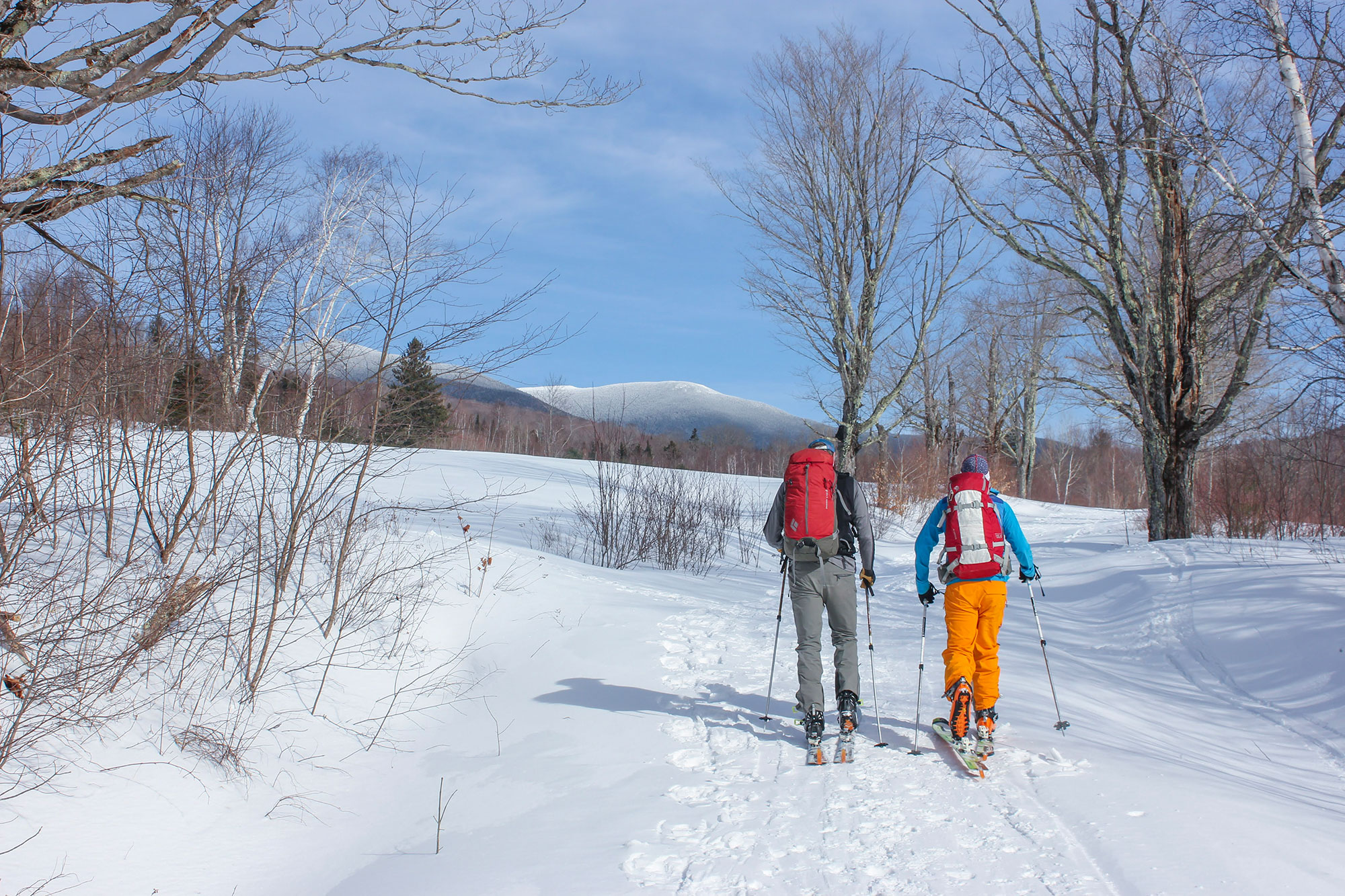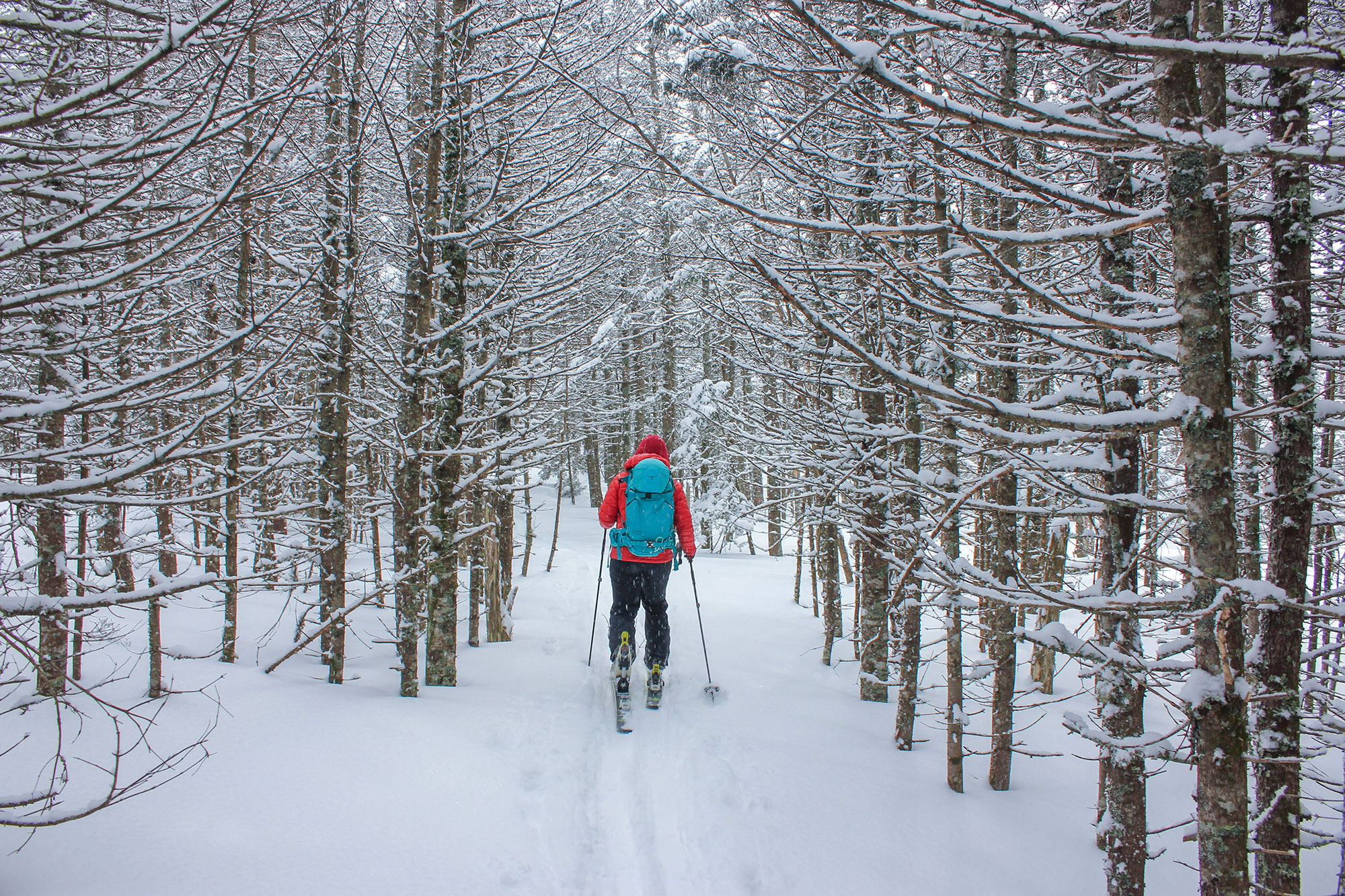Climbing skins are a critical component of almost every backcountry kit, providing the traction that allows self-powered skiers and splitboarders to glide uphill without sliding downhill. Selecting the right type and size of skin is essential for efficient and reliable travel and can make or break a day in the backcountry. To help you find the right skins for your backcountry adventures, here are some tips on the different types of materials used to make skins as well as how to size them correctly for your skis or splitboard.

Climbing Skin Construction
Climbing skins are primarily made of two materials, but available in three arrangements: nylon, mohair, and nylon-mohair mixes. The opposite side of the skin is adhesive (often a skin glue) and sticks to the bottom of the ski. At the top of the ascent, the skin is peeled off the ski and stored for the descent.
Picking the right skin for your setup involves balancing the skin’s grip (i.e., the traction that prevents sliding backward) versus its glide (i.e., the skin’s forward slide as the skinner moves uphill).
- Nylon skins are typically the most affordable and durable option. They provide superior grip and don’t require great skinning technique, but are heavier, bulkier, and don’t glide as well as other options.
- Mohair skins are made from the hair of Angora goats and are known for being lightweight, packable, and great at gliding—making them well-suited to racers, big objectives, and super-wide powder skis. The downside of mohair skins is that they’re generally expensive and wear faster than other types of skins.
- Nylon/Mohair skins deliver the best of both worlds—they provide a good compromise between grip and glide, pack up reasonably small, are lighter than their nylon counterparts, and are relatively durable.

Climbing Skin Configurations and Sizes
Climbing skins are sold in two major configurations: either specifically tailored to a make, model, and size ski, or universally-sized and adaptable to a broad spectrum of skis that share a similar length or width. Pre-cut skins are very straightforward—just match the skin to the ski and you’re good to go. Selecting universal skins requires a little more thought and effort.
Pre-Cut Skins
Pre-cut skins make selecting skins easy—they’re sized correctly out of the box and don’t require any trimming. Some brands of pre-cut skins even feature special mounting systems designed to work specifically with the same brand of skis. The downside of pre-cut skins is they cut down on options (choice of manufacturer and construction, for example).
Sizing Universal Climbing Skins
When choosing universally-sized climbing skins, it’s important to know the length and width of the ski that the skin will pair with. Like skis, climbing skins are measured in millimeters. The dimensions of a ski are commonly found on the top sheet and readily available online.
Most universal climbing skins are designed to cover a range of ski lengths—these skins feature fixed tips and tails and it’s important to select a skin within a length range that includes your ski. Some universal skins will require trimming to length and affixing tips and tails—although these are less common. Making universal skins work outside of their recommended length ranges is possible in some cases, although it’s tricky and often more trouble than it’s worth. If your ski falls under multiple length ranges, you’re given a choice to size up or down. Larger skins provide more coverage and better grip, but sizing down is the lighter, more packable option.
Universal climbing skins also come in various widths, with the size measured based on the widest part of the ski—generally the tip. Skins are trimmed to the proper width using a skin tool. The closer you can match skin width to ski width when purchasing skins the better, as it cuts down on waste and reduces the chances of having a compatibility issue with the tip attachment.

Cutting Skins
Most climbing skins come with a trimming tool and instructions—it’s worth familiarizing yourself with both before you begin cutting since there’s no turning back once you begin trimming. If the skins don’t come with a trimming tool, a box cutter or Exacto knife will work.
Normally, you’ll want the skin to match the shape of your ski while leaving roughly two millimeters of the ski’s base/edge exposed. This allows you to still use your ski’s edges when the skin is affixed, which is pretty important when side-hilling or negotiating icy terrain—something you’ll likely encounter skinning in the Northeast. Weight-conscious backcountry skiers will also often trim a little extra from the parts of the skin (especially on fatter skis) that don’t come in contact with the snow, like the tip on a heavily rockered ski.
To trim skins:
- Affix the skin as if you were going out on a tour
- Center the skin and trim it flush with the sides of the ski working tip to tail
- Remove the skin and reapply it so that roughly 2 mm of skin extends past one of the edges
- Trim and repeat for the other side
Remember, cuts are final. So take your time to ensure everything is correct before trimming. It’s also worth noting that some skin manufacturers have taken the guesswork out of trimming skins and include easy-trim tools that are engineered to leave the appropriate amount of edge exposed.
Take It to a Pro
The good news about trimming skins is that it’s hard to screw them up too badly. Most skins will work just fine, even if you trimmed off more than 2 mm per side and while an uncentered skin is unpleasing aesthetically, they get the job done just fine in the skin track. If the idea of trimming your own skins is too stressful or you can’t stomach the idea of trimming them yourself, bring them to your local shop and let a pro take care of it for you.
Tim Peck and Doug Martland
Tim and Doug met long ago at the Eastern Mountain Sports in Canton, Massachusetts. Bonding over a love of slick Quincy Quarry granite, White Mountain sufferfests, and scheming up adventures while folding tee-shirts, today Tim and Doug collaborate to write about their favorite outdoor activities and occasionally get nostalgic about tee-shirt tables.




